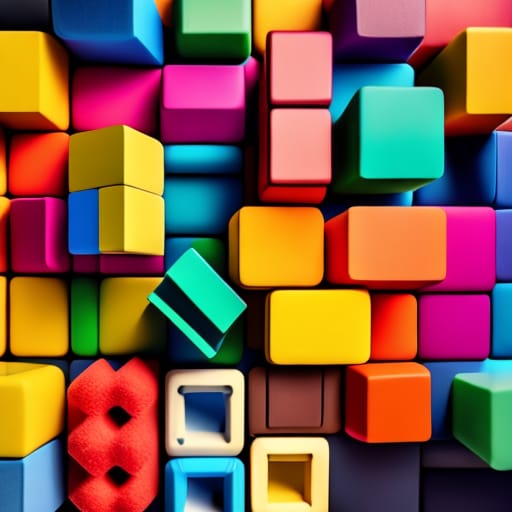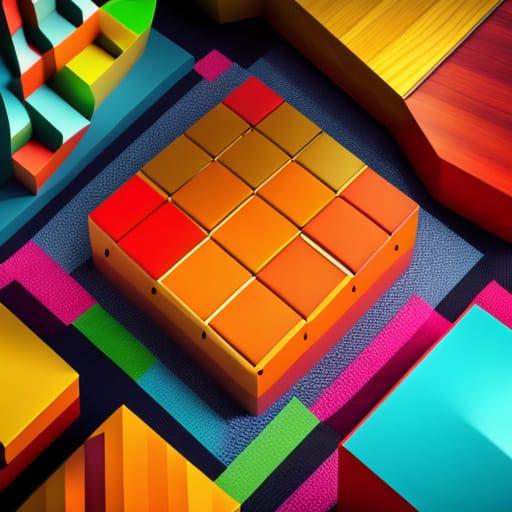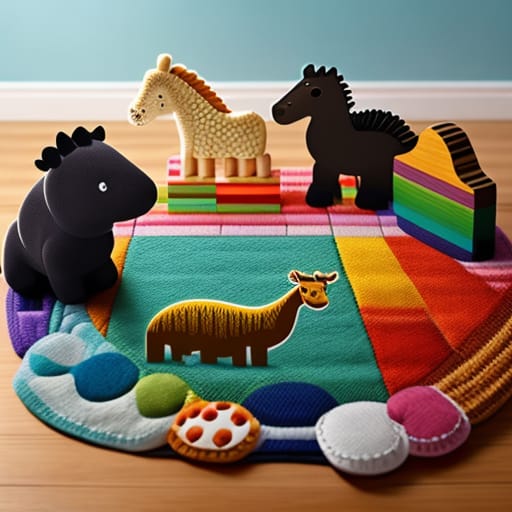Wooden blocks are a classic, versatile toy that has endless possibilities for fun and learning. This comprehensive beginner’s guide covers everything you need to know about wooden blocks for kids.

An Introduction to Wooden Blocks
Wooden blocks are simple yet open-ended toys made of natural wood that inspire creativity in children. Often sold in basic shapes like squares, rectangles, triangles, arches, and cylinders, wooden blocks come in rainbow colors and smooth sanded textures.
Blocks made of hardwood like maple, oak, ash, and beech tend to be the highest quality as they are dense, durable woods that easily withstand drops and bites from little teeth. The best sets feature uniform block sizes that easily stack and don’t topple over easily.
Wooden blocks originated in the 18th century from pioneer children playing with leftover wood scraps. They became widespread in the 1900s when developmental experts recognized their benefits in building early STEM and motor skills.
Today wooden blocks remain popular in Montessori, Reggio Emilia, and Waldorf educational models as open-ended “toys with no specific purpose” that inspire creativity. The simple, natural material allows children to build anything imaginable.
Wooden blocks boost development across multiple domains:
- Cognitive – creativity, problem solving
- Motor – stacking, grasping
- Math & Science – sorting, gravity experiments
- Literacy – spelling letter blocks
- Emotional – confidence in creations
- Social – collaborative building
No batteries or screens are required! Wooden blocks unlock skills across early childhood development.
Types of Wooden Blocks
While traditional cube and rectangular blocks remain popular, wooden blocks now come in diverse shapes, sizes, and styles. Different types of blocks suit children at various ages depending on their developmental stage.
1. Basic Beginner Blocks
- Best for ages 1-3 years
- Focus on grasp and stack motor skills
- Typically large, simple cubes and rectangles
- Bright rainbow colors
- Machine-smoothed sanded edges
2. Alphabet & Number Blocks
- Best for ages 2+ years
- Learn letters, words, spelling, counting
- May include capital letters on one side, lowercase on the other
- Some sets include math symbols
3. Imaginative Themed Blocks
- Best for ages 3+ years
- Creative open-ended play
- Themed collections like animals, transportation, careers
- Encourage pretend play, storytelling
- Combine with basic blocks
4. Advanced Building Blocks
- Best for ages 4+ years
- Enhanced building opportunities
- Arches, cylinders, triangles, ramps, pillars
- Stack vertically and horizontally
- More structural stability than basic cubes
| Type | Ages | Skills |
| Basic Rainbow Blocks | 1-3 years | Grasping, stacking |
| Alphabet & Number Blocks | 2+ years | Literacy, math |
| Themed Imaginative Blocks | 3+ years | Creativity, pretend play |
| Advanced Building Blocks | 4+ years | Engineering, problem solving |
With such diversity, you can amass quite a wooden block collection as your child grows! Themed and advanced blocks build on basic block skills.

Key Benefits of Wooden Blocks
Open-ended wooden blocks that children use as their imagination sees fit provide a host of developmental benefits beyond just fun.
Spatial Skills
Stacking, organizing, and manipulating blocks in space boosts spatial relations and visual perception. Assembling structures requires visualizing objects in 3D and from different perspectives.
Math & Science
Exploring concepts like gravity, balance, symmetry, fractions, and geometry emerges naturally through block play. Sorting by size, shape and color introduces classification and categorization skills.
Motor Skills
Lifting, grasping, carrying, and manipulating wooden blocks builds fine and gross motor control. Building towers and balancing trains uses coordination and controlled movement.
Creativity & Storytelling
Storytelling emerges as children animate their wooden block creations with inventive narratives. Open-ended play encourages creativity, problem solving, and confidence.
Beyond tangibles like math concepts and hand-eye coordination, wooden blocks grant permission to experiment and invent without boundaries. It’s learning disguised as fun!
“Play is often talked about as if it were relief from serious learning, but for children, play is serious learning.” – Mr. Rogers
Choosing Quality Wooden Blocks
With an overwhelming number of wooden blocks available, focus on a few key factors when selecting a set:
1. Safety
Always choose non-toxic blocks made without chemical finishes. Reputable brands test for safety standards. High-quality hardwoods like maple and beech naturally withstand constant use.
2. Durability
Hardwood blocks last substantially longer than soft pine sets without splintering. Ensure thickness between 0.5-1 inch for stability. Some sets indicate the European beechwood durability rating from 1 (least durable) to 5 (most durable).
3. Design
Seeking uniform block sizes in basic cubes/rectangles ensures proper stacking and building. Interesting colors, themes, and shapes enhance play. Smooth, sanded edges prevent injuries. No embellishments should loosen with use.
4. Company Values
Support brands that focus on open-ended play and healthy child development vs excessive commercialization. Creative, eco-friendly products sustain long-term enjoyment.
5. Price
While cheaper blocks may seem appealing, poor-quality materials wear out quickly. Invest in the $75-150 range for superior hardwoods that withstand years of play. Consider price per block vs total cost.
Grimm’s Basic Rainbow Wooden Blocks
- $100
- 75 maple blocks
- 2-6 years old
- Cube and rectangular shapes
Grapat Advanced Building Block Set
- $145
- 95 beechwood blocks
- 4+ years old
- Arches, pillars, triangles
- Recognized for quality craftsmanship
Investing in high-quality blocks made traditionally by European woodworkers sustains years of enjoyment and developmental benefits.

Maximizing the Power of Wooden Block Play
Simply opening the box and allowing free play with wooden blocks reaps rewards for young children. However, curating block activities to target specific skills takes block play to the next level.
Literacy Activities
Fortify emerging reading skills with inventive block play:
- Build letter structures using alphabet blocks
- Spell simple words by stacking letter blocks
- Construct objects that start with letter sounds
- Tell stories with block scenes & characters
Math Challenges
Wooden blocks provide a hands-on approach to build math competence:
- Categorize by color, shape, or size
- Create repeating patterns and sequences
- Explore symmetry and dimensions
- Count blocks to develop number sense
Spatial Activities
Boost spatial reasoning, geometry, and engineering thinking:
- Build tall towers and wide bridges
- Create enclosure shapes with openings
- Balance irregular shapes
- Construct buildings, cities and towns
Playful Life Skills
Nurture confidence, creativity problem-solving and more with pretend play storytelling:
- Recreate scenes from stories and real life
- Dramatize fantasy worlds and mythical kingdoms
- Animate adventures with characters
- Display block creations proudly
Add props like toy people, vehicles and signs to enrich the narratives and possibilities. Snap photos to document block creations and chronicle the learning journey.
Final Takeaways
Open-ended wooden blocks equip little builders with the tools to construct anything imaginable while building crucial developmental skills along the journey.
Choose ethically-made natural hardwood blocks sized for little hands without embellishments that loosen. Seek interesting colors and shapes to spark creativity. Build literacy, math and motor skills through playful block challenges tailored to your child’s age.
Most importantly, let those little imaginations soar by trusting the child-led creative process with wooden blocks! Diverse collections sustain endless play possibilities as skills progress with age to nurture tomorrow’s big thinkers.
To discover more about the wonderful world of wooden blocks, check out these helpful resources:
- International Playthings – The Benefits of Block Play
- NAEYC – Block Corner Set Ups for Early Childhood Classrooms
- Working Mother – How Playing with Wooden Blocks Supports Early Development
- The Genius of Play – How Blocks Build Skills
- Childcare Exchange – Wooden Block Play
Frequently Asked Questions
What’s the best age for wooden blocks?
- Start as early as 12 months with basic grasping and carrying. Age 2-4 years sees tremendous open-ended building and imaginary play. Add advanced blocks around 4 years as skills progress. But wooden blocks captivate children as old as 8 years when creativity peaks before peer play priority emerges.
How many blocks are ideal?
- At least 30-50 blocks ensure adequate pieces for building. Boost the number to 80-100 pieces for more complex structures. Go for bigger sets with diverse shapes to take creations to the next level.
Should we limit wooden block playtime?
- Unlike screens that overstimulate young brains, enjoy endless unstructured wooden block playtime. However, create boundaries for putting blocks away neatly when play concludes. And supervision ensures proper use and sharing.
Which blocks are safest?
- Natural maple, oak, ash and beech wood blocks ensure safety. Avoid painted and varnished blocks with potentially toxic finishes. European manufacturers like Grimm’s and Grapat adhere to strict safety standards, ensuring years of safe block play.
How can I store wooden blocks?
- Durable wooden storage bins corral stray blocks neatly while keeping them accessible for play. Some even boast color-coded sorting trays and locking caster wheels for mobility. Use fabric cubes or baskets to stash smaller sets.
What skills do wooden blocks build?
- Wooden blocks build skills across cognitive, motor, math, science, literacy, emotional, and social domains through open-ended play. Key skills include spatial relations, engineering thinking, categorization, hand-eye coordination, vocabulary, storytelling and more!
Why choose wooden over plastic blocks? Sustainably-sourced wooden blocks feature natural textures and smooth hardwood feel that stimulate senses and last for years. The durability, classics styles and eco-friendly nature makes wooden blocks far superior to trendy licensed plastic blocks.